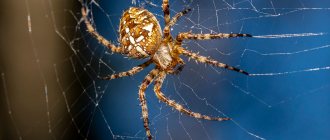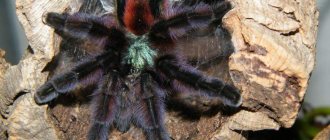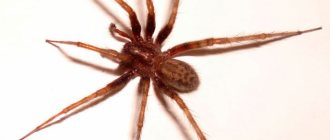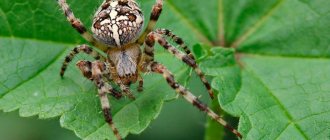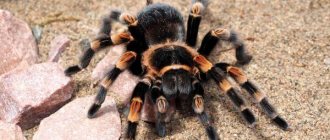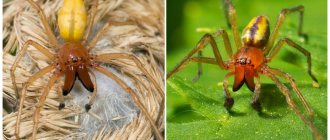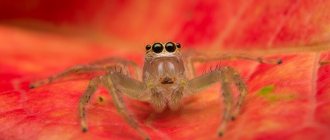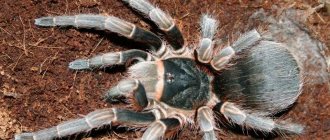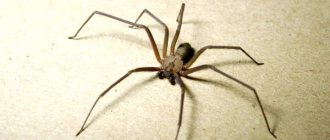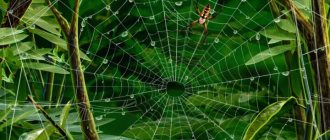The South Russian tarantula or Mizgir (Lycosa singoriensis) is a relatively large arachnid whose habitat is gradually expanding. More and more often, the spider is found in gardens and vegetable gardens, and sometimes it gets into houses. The impressive size of the spider and other external features often frighten people, who, in turn, provoke the tarantula to attack.
South Russian tarantula (mizgir), appearance
Name
In Russian and Ukrainian it is called the South Russian tarantula (due to the distribution of the species in the south of Russia). Popularly called “mizgir”.
In other languages, it is often named after the territories where it is found: Romanian (Romanian românească), Tatar (Czech tatarský), Ukrainian (Polish ukraińska), Dzungarian and the like.
Female
Mizgir bite
The spider is not aggressive and does not attack first. Its poison is not fatal to humans, but is dangerous to small animals. The bite can be compared to a hornet sting. Symptoms may include:
- swelling, burning;
Tarantula bite.
- presence of 2 punctures;
- redness;
- pain;
- in some cases, increased temperature;
- yellowed skin in the affected area (the shade may persist for 2 months).
The bite of a South Russian tarantula is dangerous only for a person prone to allergic reactions. A person develops a rash, blisters, vomiting, a very high temperature rises, the heart rate increases, and the limbs go numb. In such cases, immediately call an ambulance.
First aid for a misgir bite
A few tips for disinfecting the wound and restoring the skin:
- wash the bite site with soap and water;
- treated with any antiseptic. Hydrogen peroxide, alcohol, vodka will do;
- apply ice to relieve pain;
- take antihistamines;
- apply an anti-inflammatory agent (for example, Levomycytin ointment);
- drink a lot of fluids to remove toxins from the body;
- The bite site is kept elevated.
Description
One of the largest spiders in Europe, the largest in Central Europe and Ukraine. Body size up to 4 cm, with legs up to 7 cm. Body weight from 2.6 to 7 grams. The upper side of the body is variegated, the sides are light, the upper side of the abdomen is black. The body is covered with gray and white hairs of different lengths, so it looks shaggy. On the cephalothorax there is a pattern of dark stripes extending radially from the center. The main segment of the chelicerum is bright yellow or orange, the tip and claw are black. The pedipalps are also yellow except for the black tip. Legs underneath with black rings.
Thanks to its protective coloring, the South Russian tarantula is perfectly camouflaged on the soil surface
Sexual dimorphism
Females have a larger abdomen and short legs compared to males and are stockier. The hairs of males are lighter. The size of males is 14–27 mm, females - from 18 to 31 mm, according to some sources - up to 35 mm.
Male
Races
There are three “races” of South Russian tarantulas: large, small and intermediate. The large one is found only in the south of Central Asia, the intermediate one is found most northern. Small common in the south of the steppes. All races interbreed freely with each other.
How do they reproduce?
Most often, reproduction in tarantulas occurs in the second half of August. The male weaves a web somewhere in a safe place, and then rubs his abdomen against it. Ejaculation occurs, the fertilization fluid remains on the web. After this, the male lowers the pedipalps there, they absorb the seed and become ready for fertilization of the female tarantula.
Spiders have a courtship period - when they find a female, they perform a dance for her. If the female responds favorably, the male lowers the pedipalps into her cloaca, after which fertilization occurs. An interesting point: the male needs to hide from the fertilized individual as quickly as possible, otherwise she may eat him.
After fertilization, the concern for prolongation of the race passes to the female. She weaves a cocoon where the eggs will be laid. The maximum quantity per clutch is up to 2,000 eggs. They mature for up to 50 days, after which small arthropods are born. As a rule, they reach sexual maturity by 2-3 years.
Lifestyle
The lifestyle is similar to that of the closely related Apulian tarantula (Lycosa tarantula).
Female in the ornithological reserve Bulakhovsky Estuary, Ukraine, Dnepropetrovsk region
Nutrition
The female South Russian tarantula digs a more or less vertical hole up to 50–60 cm deep, the inner wall of which is covered with cobwebs. The entrance to the hole is about the diameter of a mouse hole, the web protrudes from the surface of the soil and is reinforced by twisted stems of grass and other plants. It does not build a trapping net, but reacts to the movement of prey, which approaches the edge of the burrow and pulls the signal spider threads: it jumps out of the burrow and bites. At night it moves a short distance from the shelter. It most often hunts beetles and orthoptera, but any insects and smaller spiders can become prey.
At the entrance to the hole
Reproduction
Tarantulas mate in late summer. The male approaches the female's burrow and taps the web with his front legs. The female comes out, and then he begins to stroke her limbs with a slight vibration of his legs. Sometimes the female will still attack the male. When the male manages to calm her down, he enters the hole, where mating takes place.
Entrance to the hole
In the spring, the female lays 200–700 eggs in a cocoon, which she warms in the sun, crawling out to the edge of the burrow and sitting there upside down, with her abdomen with the attached cocoon out. After the small spiderlings hatch (usually in May), she collects them on the upper part of her abdomen and travels, from time to time dropping some of the offspring, thus distributing them. At the same time, the female can swim across small water obstacles.
The female before laying eggs. After laying eggs, the size of the abdomen decreases sharply
Female with cubs, Chelyabinsk region
Tarantulas grow during molting, molting 11 times.
Female with young
Growing at home
South Russian tarantulas are rarely found as pets. It is interesting to watch them while hunting and while arranging their home. It won't be possible to tame.
If the spider notices too intrusive attention, it will bite. At home, South Russian tarantulas live from 1 to 3 years. In warm conditions, Mizgir does not hibernate, which slows down its development.
An ordinary aquarium can also become a home for a tarantula, but it must have good ventilation. The length and width of the container should exceed the paw span by approximately 3 times. A cover is also required - the spider can easily jump up to 20 cm, and can also get out into the corners, entwining them with cobwebs.
You need to pour loose material on the bottom:
- sand;
- vermiculite;
- turf;
- coconut fiber;
- peat.
As an option: on one side of the container - clay and sand in half, on the other - vermiculite and black soil. The thickness of the layer must be at least 40 cm so that the tarantula can dig a full-fledged hole. The poured soil is constantly slightly moistened. You can plant plants and put natural shelters: driftwood or branches. There is a lamp on top (mizgiri like to warm themselves).
Cleaning must be done every 2 months. The spider is removed with a net or lured with food into another container.
You can catch food for your tarantula yourself or buy it at a pet store. These could be cockroaches, crickets, mealworms, moths, and larvae. Young spiders are allowed to be given as many insects as they can consume.
Usually they launch 5-7 cockroaches. If the tarantula does not eat for 5-6 days (this usually happens before molting), then the insects need to be caught. For adults, it is enough to feed them once a week (1-2 crickets or cockroaches). Tarantulas can live without food for about a year, but they must always have access to water.
It should be taken into account: the better the Mizgir feeds, the more often it will shed - the chitinous shell becomes tight as it grows. However, the number of molts is directly proportional to the spider's lifespan. A strict diet will prolong its existence.
At home, females also breed offspring, which spread out after about 3 days (on the 4th day the body of the young is the size of a match head). Then the spider weakens and dies. For active growth of young animals, a stable temperature (30-31˚) and abundant nutrition are required.
Video
South Russian Tarantula (Lycosa Singoriensis) or Mizgir - Housekeeping!
Natural enemies
Tarantulas are preyed upon by parasitoid road wasps (pompylids), which paralyze the spiders and lay eggs on them, from which a larva develops that slowly eats the spider. In particular, these are Anoply Samara (listed in the Red Books of Chuvashia, Ukraine and Moldova) and Cryptochol annularis (listed in the Red Book of Ukraine).
Cryptocheilus alternatus
The eggs are destroyed by various species of ichneumon ichneumon. Young tarantulas are hunted by mole crickets.
In Kazakhstan, tarantulas are eaten by the endemic rodent Selevinia, which, however, is rare.
Spreading
Distributed in deserts, semi-deserts, steppes and forest-steppes from Austria and Hungary to the Caspian Sea, Central Asia, Southern Siberia, the Russian Far East and Northwestern China. Also lives in Turkey, the Middle East, and Egypt. In Ukraine, it is distributed throughout almost the entire territory, except for the main part of the Carpathians (however, it is found in the Volcanic Massif). Occasionally found further north, especially along river banks with sandy soils.
What not to use for fighting
When exterminating spiders, you should avoid using the following methods:
If there are few spiders in the dacha and they do not cause discomfort, there is no need to exterminate them. In nature, arthropods perform an important function by reducing insect populations and protecting plants from pests. This recommendation does not apply to areas with large numbers of spiders. The magazine “Super Summer Resident” recommends: “when a large space is covered with cobwebs, you should contact the sanitary service.”
Security
It is included in the Red Books of many constituent entities of Russia, in particular the Moscow, Kaluga, Ryazan, Tula, Sverdlovsk and Nizhny Novgorod regions, and the Perm Territory. In Ukraine, it is included in the list of animals subject to protection in the Kyiv region.
In the landscape reserve of national significance Soleny Liman, Ukraine
Interesting facts about the Cornerot jellyfish
There are several interesting facts about it, but the main one is that some types of these animals are eaten by people. For example, the edible sawweed (from the Latin Rhopilema esculenta) is considered a popular species. This jellyfish is part of the national dishes of Japanese and Chinese cuisines.
Another interesting fact is that such meat is not consumed in its pure form. Jellyfish are usually added to various salads, which are subsequently flavored with a huge amount of all kinds of seasonings.
Cornerot is harmless as long as it is not disturbed. However, as soon as the animal feels irritated, the tentacles will immediately release poison that can cause a serious burn.
Watch a video about a poisonous jellyfish in the Black Sea:
South Russian tarantula and man
Unlike the Apulian tarantula, the South Russian tarantula is almost not feared in its range. There are even reports from Ukraine of children playing with tarantulas to pass the time.
Bite incidents and toxicity
The spider's chelicerae are large and strong enough to bite through human skin. However, the effect of the poison itself has practically no significant consequences for humans. Redness and swelling occur in the area of the bite wound. Rarely, the bite can also cause a fever. In any case, bites are rare due to the low aggressiveness of the spider. As a rule, in case of danger, the South Russian tarantula prefers to hide and bites only if there is no other way out - for example, a spider has been driven into a corner. Before biting, it straightens up and raises its front pairs of legs.
In a terrifying pose
Difference from tarantula
Tarantulas are often confused with the tarantula spider, so to put an end to this, here are the differences between them:
